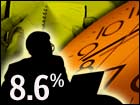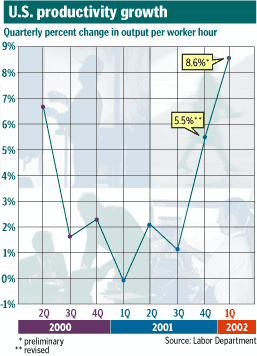
NEW YORK (CNN/Money) -
U.S. productivity posted its biggest gain in nearly 19 years in the first quarter, the government said Tuesday, potentially good news for corporate profits but bad news for a labor market still emerging from recession.
The news came as Federal Reserve policy makers met to discuss the economy and interest rates, and helped cement the idea that they will leave their target for short-term rates at a 40-year low since the strength of economic recovery is still in doubt.
The Labor Department said U.S. productivity -- a key measure of worker output per hour -- rose at an 8.6 percent annual rate in the first quarter after growing at a revised 5.5 percent rate in the fourth quarter. Worker hours fell 1.9 percent in the first quarter, while output grew 6.5 percent.
"Businesses have spent the last year restructuring and managing their work forces cautiously," said Joel Naroff, president and chief economist at Naroff Economic Advisors in Holland, Pa. "It is paying off. Companies managed to squeeze every last ounce of production out of their workers, and it showed."

It was the best performance since a 9.9 percent gain in the second quarter of 1983. Economists surveyed by Briefing.com expected productivity to grow 7.0 percent in the period.
The Labor Department said the data were somewhat skewed by a dramatic drop in the hours of self-employed workers, which make up 9 percent of the total work force. They contributed 1.2 percentage points to the overall 1.9-percent drop in total worker hours. Excluding self-employment data, which are often volatile, productivity grew just 7.4 percent, closer to expectations.
Separately, the Commerce Department reported that wholesale inventories were unchanged in March after falling 0.9 percent in February. Economists surveyed by Briefing.com expected inventories to fall 0.4 percent.
Higher productivity, in recent years the result of investment in efficiency boosting technology, can help companies earn more without having to boost wages -- which, in theory at least, can help boost corporate profitability.
Another boost to profit margins was a 5.4-percent plunge in unit labor costs, the biggest drop since the second quarter of 1983, when costs fell at a 6.5-percent rate, according to the Labor Department.
"The good news is that this is going to go directly to the corporate bottom line," former Fed economist Wayne Ayers, now chief economist at Fleet Boston Financial, told CNNfn's Before Hours program. "That's a real plus for profits, which means a real plus for corporate spending and the recovery going forward."
Wall Street wasn't so sure at first, but U.S. stock prices were mostly higher in early afternoon trading following Monday's selloff; the Nasdaq moved into positive territory after losing ground in morning trading. Treasury bond prices were mixed.
Bad news for the labor market
For all of 2001, during much of which the economy was most likely in recession, productivity rose just 1.9 percent, the worst performance since a 0.9 percent gain in 1995.
But the surge in productivity in the latest quarter came at the expense of worker hours, the Labor Department said. And with businesses operating more efficiently, it's unlikely they will hire new workers until they see enough demand to justify ramping up production.
"There doesn't seem to be any real urgency for firms to start hiring, precisely at a time we're seeing a reemergence of people becoming interested in looking for a job," said Anthony Chan, chief economist at Banc One Investment Advisors. "Put the two together, and you have a formula for higher unemployment."
Though Chan disagreed with some economists, such as Morgan Stanley chief economist Stephen Roach, who believe the economy will have a "double dip" recession this year, he did say the recovery will look much like the one that followed the 1990-91 recession, when the economy grew, but few jobs were added.
Unemployment jumped to 6 percent in April, the Labor Department reported last week, the highest level since August 1994.
Labor market weakness and the ability of higher productivity to keep prices lower and inflation at bay will keep the Fed, which watches productivity closely, from raising interest rates Tuesday, many economists believe.
"I don't think they needed an excuse to sit on their hands, and clearly they're going to do that," former Fed economist Ayers said. "They may not even move until [their] August [meeting] at the earliest. They have all the flexibility they need, given the weakness of the labor market, and this [productivity report] gives them even more so."
To keep consumers spending during the downturn, the Fed cut rates 11 times last year to make borrowing cheaper and put more money in consumers' pockets. The central bank's efforts probably helped make the recession one of the mildest and shortest in history.
| |
 Related links
Related links
| |
| | |
| | |
|
The strength of the recovery is still in question, however, and will depend in large part on the willingness of companies to spend money, Fed Chairman Alan Greenspan has said.
The stability of wholesale inventories in March was a hopeful sign, meaning the process of clearing a backlog of unsold goods from businesses' shelves could be over, setting the stage for higher production in the future.
Productivity in the manufacturing sector, which has suffered the most and seen the most job cuts during the latest economic downturn, grew at a 9.7 percent rate -- 13.3 percent for durable goods such as cars and computers, and 5.1 percent for non-durable goods such as food and clothing. Output in the manufacturing sector rose at a 3.2 percent pace, while hours worked dropped 5.9 percent.

|

